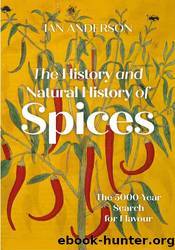The History and Natural History of Spices by Ian Anderson

Author:Ian Anderson [Anderson, Ian]
Language: eng
Format: epub
Published: 0101-01-01T00:00:00+00:00
The fifteenth to seventeenth centuries spanned a period of great geographic discovery by western European nations, as well as a European cultural renaissance. The great maritime discoveries started with a small country lacking in natural resources, but with a significant Atlantic coastline: Portugal.
Portuguese Opening of the European Spice Trade
In the fourteenth century, it was inevitable that Portugalâs future would be linked with the sea. King Denis and then his son Afonso IV started to build the Portuguese navy and a commercial fleet that would rapidly develop and lead Portugal to become a major maritime power. Given its position in the extreme west of Europe, Portugal had limited options for growth. It was already trading with north-west Europe, e.g. England, Normandy, Flanders, etc., exporting products such as wine, olive oil, salt, figs, raisins, honey and hides. Trade in the Mediterranean was difficult as those countries had the same products as Portugal or trade was dominated by Venice, Genoa and the Ottomans. Furthermore, the fall of Constantinople to the Ottomans in the mid-fifteenth century resulted in a reduction of trade between Asia and Europe. The only options were to look west into the Atlantic ⦠or south into Africa. As early as 1415, Portugal seized Ceuta on the North African coast. In 1420, the Atlantic island of Madeira was settled, followed in 1427 by the Azores. Sugarcane became a major industry in the mid-fifteenth century on Madeira. The young Prince Henrique (later known as âHenry the Navigatorâ) sponsored these adventures, which used manoeuvrable two- or three-masted caravels of less than 100 tons â he would take 20 per cent of any profits. Money, as always, was a key motivator, but he was also driven by religion and zeal for discovery (though he never joined any of the expeditions). The exploration voyages, which all set out from Lagos, pushed further south along the African coast; Cap Blanc was reached in 1441, and then in 1445 the navigator Dinis Dias reached the mouth of the Senegal River. The big prizes at this time were gold â and slaves, who were sold to Muslim merchants.
In July 1487, Bartolomeo Dias, a Portuguese mariner (and descendant of Dinis Dias), set sail from Lisbon in an attempt to search for the southern tip of Africa and round it, thereby hoping to prove up a new trade route to the East. His fleet comprised two small caravels and a supply ship.21 They reached Walvis Bay (in modern Namibia) on 8 December. Fierce storms in January forced them further south and they lost sight of land; after several days he turned northwards, and on 3 February reached Mossel Bay in South Africa, about 250km east of the Cape of Good Hope. He continued another 250km east to Algoa Bay, but with a tired and reluctant crew and diminishing supplies he was forced to head back. They finally reached Portugal in December 1488, seeing the Cape for the first time on their way back â Dias named it the Cape of Storms, but it was later changed to the more upbeat term used today.
Download
This site does not store any files on its server. We only index and link to content provided by other sites. Please contact the content providers to delete copyright contents if any and email us, we'll remove relevant links or contents immediately.
| Cheese & Dairy | Chocolate |
| Fish & Seafood | Fruits |
| Herbs, Spices & Condiments | Meat & Game |
| Natural Foods | Pasta & Noodles |
| Potatoes | Poultry |
| Rice & Grains | Vegetables |
Trullo by Tim Siadatan(3020)
The French Women Don't Get Fat Cookbook by Mireille Guiliano(3013)
Better Homes and Gardens New Cookbook by Better Homes & Gardens(2988)
Super Food Family Classics by Jamie Oliver(2936)
Panini by Carlo Middione(2849)
Hedgerow by John Wright(2803)
Bread Revolution by Peter Reinhart(2666)
Sauces by James Peterson(2616)
Jam by Jam (epub)(2517)
Ottolenghi - The Cookbook by Yotam Ottolenghi(2382)
Oh She Glows Every Day by Angela Liddon(2333)
Hot Sauce Nation by Denver Nicks(2127)
The Culinary Herbal by Susan Belsinger(2078)
My Pantry by Alice Waters(2069)
The Art of Making Gelato by Morgan Morano(1916)
Veg by Jamie Oliver(1913)
Meathooked by Marta Zaraska(1912)
Basic Illustrated Edible and Medicinal Mushrooms by Jim Meuninck(1910)
Wanderlust by Jeff Krasno(1906)
